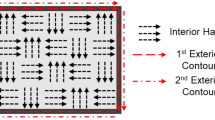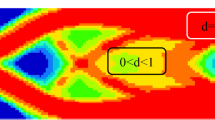Abstract
The primary driver for technological advancement in design methods is increasing part performance and reducing manufacturing cost. Design optimization tools, such as topology optimization, provide a mathematical approach to generate efficient and lightweight designs; however, integration of this design tool into industry has been hindered most notably by manufacturability. Innovative processes, such as additive manufacturing (AM), have significantly more design freedom than traditional manufacturing methods, providing a means to develop the complex designs produced by topology optimization. The layer-wise nature of AM leads to new design challenges such as the need for support material, influenced by part topology and build orientation. Previous works addressing approaches to limit support material often rely on the finite element discretization scheme, leading to a gap between solving academic and practical problems. This study presents an approach to simultaneously optimize part topology and build orientation with AM considerations. Utilizing the spatial density gradient in the topology optimization formulation, the dependence on the finite element discretization scheme is reduced. The proposed approach has the potential to significantly decrease support material, while having a minimal impact on structural performance. Both 2D and 3D academic test problems, as well as an aerospace industry example, demonstrate the proposed methodology is capable of generating high-quality designs.




























Similar content being viewed by others
References
Allaire G, Dapogny C, Faure A, Michailidis G (2017) Shape optimization of a layer by layer mechanical constraint for additive manufacturing. Comptes Rendus Math 355:699–717. https://doi.org/10.1016/J.CRMA.2017.04.008
Bendsøe MP, Kikuchi N (1988) Generating optimal topologies in structural design using a homogenization method. Comput Methods Appl Mech Eng 71:197–224. https://doi.org/10.1016/0045-7825(88)90086-2
Bendsøe MP, Sigmund O (1999) Material interpolation schemes in topology optimization. Arch Appl Mech. https://doi.org/10.1007/s004190050248
Brackett D, Ashcroft I, Hague R (2011) Topology optimization for additive manufacturing. In: 22nd Annual International Solid Freeform Fabrication Symposium—an additive manufacturing conference, SFF 2011. pp 348–362
Clausen A, Andreassen E (2017) On filter boundary conditions in topology optimization. Struct Multidiscip Optim 56:1147–1155. https://doi.org/10.1007/s00158-017-1709-1
Florea V, Pamwar M, Sangha B, Kim IY (2019) 3D multi-material and multi-joint topology optimization with tooling accessibility constraints. Struct Multidiscip Optim:1–28. https://doi.org/10.1007/s00158-019-02344-1
Gaynor AT, Guest JK (2016) Topology optimization considering overhang constraints: eliminating sacrificial support material in additive manufacturing through design. Struct Multidiscip Optim 54:1157–1172. https://doi.org/10.1007/s00158-016-1551-x
Guo X, Zhou J, Zhang W et al (2017) Self-supporting structure design in additive manufacturing through explicit topology optimization. Comput Methods Appl Mech Eng 323:27–63. https://doi.org/10.1016/j.cma.2017.05.003
Harzheim L, Graf G (2006) A review of optimization of cast parts using topology optimization. Struct Multidiscip Optim 31:388–399. https://doi.org/10.1007/s00158-005-0554-9
Hussein A, Hao L, Yan C et al (2013) Advanced lattice support structures for metal additive manufacturing. J Mater Process Technol 213:1019–1026. https://doi.org/10.1016/j.jmatprotec.2013.01.020
Kawamoto A, Matsumori T, Yamasaki S et al (2011) Heaviside projection based topology optimization by a PDE-filtered scalar function. Struct Multidiscip Optim 44:19–24. https://doi.org/10.1007/s00158-010-0562-2
Langelaar M (2017) An additive manufacturing filter for topology optimization of print-ready designs. Struct Multidiscip Optim 55:871–883. https://doi.org/10.1007/s00158-016-1522-2
Langelaar M (2016) Topology optimization of 3D self-supporting structures for additive manufacturing. Addit Manuf 12:60–70. https://doi.org/10.1016/j.addma.2016.06.010
Langelaar M (2018) Combined optimization of part topology, support structure layout and build orientation for additive manufacturing. Struct Multidiscip Optim 57:1985–2004. https://doi.org/10.1007/s00158-017-1877-z
Lazarov BS, Sigmund O (2011) Filters in topology optimization based on Helmholtz-type differential equations. Int J Numer Methods Eng 86:765–781. https://doi.org/10.1002/nme.3072
Leary M, Merli L, Torti F et al (2014) Optimal topology for additive manufacture: a method for enabling additive manufacture of support-free optimal structures. Mater Des 63:678–690. https://doi.org/10.1016/j.matdes.2014.06.015
Li C, Kim IY, Jeswiet J (2015) Conceptual and detailed design of an automotive engine cradle by using topology, shape, and size optimization. Struct Multidiscip Optim 51:547–564. https://doi.org/10.1007/s00158-014-1151-6
Mirzendehdel AM, Suresh K (2016) Support structure constrained topology optimization for additive manufacturing. CAD Comput Aided Des 81:1–13. https://doi.org/10.1016/j.cad.2016.08.006
Qian X (2017) Undercut and overhang angle control in topology optimization: a density gradient based integral approach. Int J Numer Methods Eng 111:247–272. https://doi.org/10.1002/nme.5461
Research and Markets (2019) Additive manufacturing market to 2027—global analysis and forecasts by material; technology; and end-user. https://www.researchandmarkets.com/reports/4756884/additive-manufacturing-market-to-2027-global
Ryan L, Kim IY (2019) A multiobjective topology optimization approach for cost and time minimization in additive manufacturing. Int J Numer Methods Eng 118:371–394. https://doi.org/10.1002/nme.6017
Sabiston G, Kim IY (2019) 3D topology optimization for cost and time minimization in additive manufacturing. Struct Multidiscip Optim:1–18. https://doi.org/10.1007/s00158-019-02392-7
Sigmund O, Petersson J (1998) Numerical instabilities in topology optimization: a survey on procedures dealing with checkerboards, mesh-dependencies and local minima. Struct Optim 16:68–75. https://doi.org/10.1007/BF01214002
Strano G, Hao L, Everson RM, Evans KE (2013) A new approach to the design and optimisation of support structures in additive manufacturing. Int J Adv Manuf Technol 66:1247–1254. https://doi.org/10.1007/s00170-012-4403-x
Svanberg K (1987) The method of moving asymptotes—a new method for structural optimization. Int J Numer Methods Eng 24:359–373. https://doi.org/10.1002/nme.1620240207
Vanek J, Galicia JAG, Benes B (2014) Clever support: efficient support structure generation for digital fabrication. Eurographics Symp Geom Process 33:117–125. https://doi.org/10.1111/cgf.12437
Wang D, Yang Y, Yi Z, Su X (2013) Research on the fabricating quality optimization of the overhanging surface in SLM process. Int J Adv Manuf Technol 65:1471–1484. https://doi.org/10.1007/s00170-012-4271-4
Woischwill C, Kim IY (2018) Multimaterial multijoint topology optimization. Int J Numer Methods Eng 115:1552–1579. https://doi.org/10.1002/nme.5908
Wong J, Ryan L, Kim IY (2018) Design optimization of aircraft landing gear assembly under dynamic loading. Struct Multidiscip Optim 57:1357–1375. https://doi.org/10.1007/s00158-017-1817-y
Replication of results
A pseudo code is provided in Appendix 3 to assist with the replication of the results presented in this paper. The pseudo code has been generalized for 2D and 3D.
Funding
This research was funded by the Natural Sciences and Engineering Research Council of Canada (NSERC).
Author information
Authors and Affiliations
Corresponding author
Ethics declarations
Conflict of interest
The authors declare that they have no conflict of interest.
Additional information
Responsible Editor: Xu Guo
Publisher’s note
Springer Nature remains neutral with regard to jurisdictional claims in published maps and institutional affiliations.
Appendices
Appendix 1. Sharpening effect
A sharpening step is completed to post-process each design to obtain discrete element values. This is completed using a bisection algorithm to ensure that the volume fraction constraint is satisfied. Figure 29 shows the effect of sharpening using the optimization 1 geometry of the 3D cantilever beam.
Appendix 2. Convergence history
Figure 30 shows the convergence history for the proposed approach (optimization 4) for the 3D cantilever beam initialized at θx = 60; θz = 60. For the combined objective function, compliance, and build orientation design variables, the convergence is smooth and well suited for gradient-based optimization; however, the support material convergence history has unsmooth characteristics, due to the nature of how it is calculated. For example, when the build direction changes, entire support material columns can be added or subtracted to the total value.
Appendix 3. Pseudo code

Rights and permissions
About this article
Cite this article
Olsen, J., Kim, I.Y. Design for additive manufacturing: 3D simultaneous topology and build orientation optimization. Struct Multidisc Optim 62, 1989–2009 (2020). https://doi.org/10.1007/s00158-020-02590-8
Received:
Revised:
Accepted:
Published:
Issue Date:
DOI: https://doi.org/10.1007/s00158-020-02590-8






